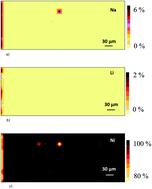Elemental mapping of structural materials for a nuclear reactor by means of LA-ICP-MS†
Abstract

- This article is part of the themed collection: 2012 Winter Conference on Plasma Spectrochemistry, Tucson, Arizona, US
* Corresponding authors
a
Laboratory of Atomic Spectrochemistry, Department of Chemistry, Faculty of Science, Masaryk University, 611 37 Brno, Czech Republic
E-mail:
viktork@chemi.muni.cz
b Central European Institute of Technology, Kamenice 5, Brno, Czech Republic
c ENERGOVÝZKUM, spol. r. o., 61200 Brno, Czech Republic
d Institute of Analytical Chemistry of the Academy of Sciences of the Czech Republic, v.v.i., 602 00 Brno, Czech Republic

 Please wait while we load your content...
Something went wrong. Try again?
Please wait while we load your content...
Something went wrong. Try again?
T. Vaculovič, T. Warchilová, T. Šimo, O. Matal, V. Otruba, P. Mikuška and V. Kanický, J. Anal. At. Spectrom., 2012, 27, 1321 DOI: 10.1039/C2JA30037K
To request permission to reproduce material from this article, please go to the Copyright Clearance Center request page.
If you are an author contributing to an RSC publication, you do not need to request permission provided correct acknowledgement is given.
If you are the author of this article, you do not need to request permission to reproduce figures and diagrams provided correct acknowledgement is given. If you want to reproduce the whole article in a third-party publication (excluding your thesis/dissertation for which permission is not required) please go to the Copyright Clearance Center request page.
Read more about how to correctly acknowledge RSC content.
 Fetching data from CrossRef.
Fetching data from CrossRef.
This may take some time to load.
Loading related content
